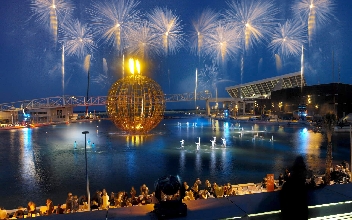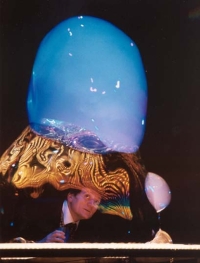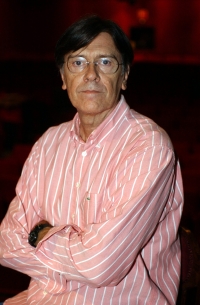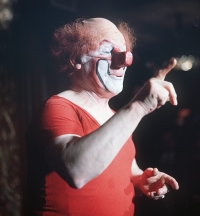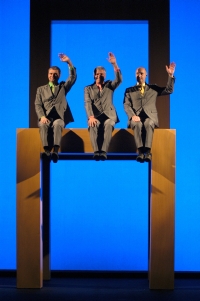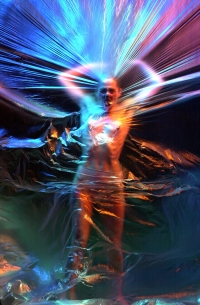

Performing Arts: Theatre, Dance and Circus 
Theatre is one of the artistic manifestations most deeply rooted in Catalan cultural tradition, starting as early as the middle ages. The true leap in this activity came in the 19th century with the beginnings of modern theatre. Frederic Soler “Pitarra” (1839-1895), the maximum exponent of Catalan theatrical romanticism, achieved success with audiences with popular, humorous works. In the Renaixença, the most international of our authors was Àngel Guimerà (1845-1924), some of whose works inspired operas and film adaptations, such as Terra Baixa and Maria Rosa. Most of his texts were first performed in the Teatre Romea (1863), now, along with the Gran Teatre del Liceu (1847), the oldest theatre in Barcelona in full operation.
The most versatile Modernista artist, Santiago Rusiñol (1861-1931) also left his mark in theatre with pieces such as L’auca del Senyor Esteve and L’heroi. Joan Puig i Ferrater (1882-1956) did so with Aigües Encantades, La Dama enamorada and El gran enlluernament. Social declarations on stage and naturalism were expressed by Ignasi Iglésias (1871-1928), the most outstanding author with works of the like of Els vells.
The influence of Paris and the intention of renovating theatre by turning to the incipient European avant-garde were the tools of the dramatist, director and theoretician Adrià Gual (1872-1943) who in 1898 founded the Teatre Íntim, and introduced the work of the main European authors of the time.
In the early 20th century, the theatre was consolidated to such an extent that in 1913 the Catalan School of Dramatic Art, the starting point of the current Institut del Teatre, was opened and run by Gual himself.
The roots of traditional theatre were maintained with Els Pastorets, works rising from medieval dramas written in Latin and performed in the liturgical events from Christmas Eve to the Epiphany. The author Josep Maria Folch i Torres (1880-1950) updated them in 1916 under the title of Els Pastorets and l’Adveniment de l’Infant Jesús, and they are still performed today on the stages of towns and cities by both amateur and professional companies.
In the early 1930s, Josep M. de Sagarra (1894-1961) made his name as a successful writer in different genres. His outstanding works such as L’Hostal de la Glòria and El café de la Marina were well received by audiences and critics alike. Ten years later he made a great contribution to theatre with his translation of Shakespeare’s works into Catalan. Another important name in early 20th-century theatre is Margarida Xirgu (1888-1969), an actress who played major roles in many of the productions of Federico García Lorca’s works. She began a tour in South America in 1936 and remained there, in exile, until her death, leaving her mark in the theatre world in the city of Buenos Aires.
During the civil war, a most significant work was produced of the dramatist Joan Oliver (1899-1986) – also a poet with the pseudonym of Pere Quart-, La fam, which talked about the war and the revolution during the conflict, and was successfully performed for the first time in the Teatre Català de la Comèdia (now Poliorama) on 15th June 1938. The recovery of Catalan performing arts was slow and difficult during the dictatorship. Salvador Espriu (1913-1985) expressed his homage to the Catalan language with Primera Història d’Esther, a mythical text that established his name as a writer. The 1950s produced new authors such as Manuel de Pedrolo (1918-1990), a representative of the theatre of the absurd, along with Joan Brossa (1919-1998), a constant experimenter in the field of theatre with his staged poetry, and Maria Aurèlia Capmany (1918-1991). 1959 was the year of the discovery of the actor Joan Capri (1917-2000), who for decades was the icon of Catalan popular theatre.
The official theatre in the time of the dictatorship, produced in the Teatre Romea, was compensated by the birth of new voices, which from the universities brought out the so-called “teatre independent” (independent theatre): the Agrupació de Teatre Experimental (1953) and the Teatre Viu (1956). Some of these young people have continued their work to the present day and have become basic figures in the second half of the 20th century in Catalan theatre, such as Feliu Formosa (1934) and Ricard Salvat (1934).
In the 1960s and 1970s brought in the generational change in dramaturgy with Josep Maria Benet i Jornet (1940), Narcís Comadira (1942) and Rodolf Sirera (1948), amongst others. This was the time of the revival of Catalan theatre with the appearance of new companies: Joglars (1962), founded by Albert Boadella (1943), Carlota Soldevila (1929-2005) and Albert Font started with mime and evolved towards social and political critique. In 1977, they were subject to a war trial for La Torna, which turned them into the symbol of freedom of expression; Dagoll Dagom (1974) with popular shows and for all audiences, especially musical, and particularly Antaviana, by Pere Calders (1978), La nit de Sant Joan, with Jaume Sisa and Mar i Cel by Guimerà; in the field of gesture theatre Tricicle (1979); in experimentation and language research La Fura dels Baus (1979) and in humour, La Cubana (1980). Mention must also be made of Joan Baixas and Teresa Calafell, who created the company Teatre La Claca in the 1970s, and brought a new language and an avant-garde approach to the art of puppetry. Mori el Merma! (1978) with puppets by Joan Miró, became a true symbol of the time.
The desire to reclaim public theatre was made manifest in 1976 with the founding of the Teatre Lliure. Created by a group of individuals involved in independent theatre, the Teatre Lliure stood out for its commitment to theatre as text, with the rereading of the classics and commitment to contemporary creation, developing a programme that alternated between dance and music. Led in successive stages by Fabià Puigserver, Lluís Pasqual, Lluís Homar, Guillem-Jordi Graells, Josep Montanyès, and now by Àlex Rigola, the theatre’s entry into the world of Catalan culture and its contribution to making theatre accessible was well-received from early on by both the audiences and critics.
Since 2003, the Teatre Lliure has presented innovative theatre which includes contemporary dance and musical theatre, making it one of the primary points of reference in the Catalan theatre world.
Street theatre and circus arts are the hallmarks of the Comediants (1971), founders of a great cultural event, the Fira del Teatre al Carrer de Tàrrega in 1981. Over time, Tàrrega has become the leader in the international market of street theatre in southern Europe. The leading professional street theatre companies include Artristras (1980), Xarxa Teatre (1983), Los Galindos (1991) and Sarruga (1994), amongst others. A new generation of street theatre is currently taking off, and a great future awaits it. Among the specific events of this genre, of note are the International Festival of Street Theatre of Vila-real (1987) and the Al Carrer festival in Viladecans (1989).
We must not overlook theatre directed to broader audiences including the young and in this regard the Jove Teatre Regina, a production and performance center for children’s and youth theatre and the Centre de Titelles de Lleida (Lleida puppet centre),which organises the puppet festival in that city, both play important roles. Among many other companies active in this area of theatre are La Baldufa, Teatre Nu Companyia Per Poc, Teatre Mobil and Xirriquiteula.
The public theatre was consolidated with the creation of the Teatre Nacional de Catalunya in 1997, born with the basic objective of offering high quality theatre both nationally and internationally, giving special attention to original works in Catalan, with one of the leading Catalan directors and actors, Josep Maria Flotats (1939), at the front. The TNC is now run by the dramatist and director Sergi Belbel (1963). Belbel represents a new generation of playwrights along with Lluïsa Cunillé (1961), Carles Batlle (1963), Jordi Galceran (1964) and Mercè Sàrries (1966). New contemporary drama includes young playwrights such as Albert Espinosa (1974), Gemma Rodríguez (1973), Pau Miró (1974), Marc Rosich (1973), and Jordi Casanovas (1978), amongst others. Some of these writers have been trained in the drama workshops organized by the Sala Beckett, established in 1989 as a working space for the El Teatro Fronterizo company, directed by José Sanchis Sinisterra, and also as place for exploring performance projects, with an emphasis on playwriting. Over the course of the last 18 years the Sala Beckett has been known for its focus on contemporary dramaturgy and very specific forms of theatre and on finding ways of connecting the audience and the playwrights. The Sala Beckett is currently under the management of stage director Toni Casares.
Over recent decades excellent directors have come to the fore, such as Calixto Bieito (1963) -widely known for both his theatre and opera productions- as well as Joan Ollé, Àlex Rigola, Mario Gas, Lluís Pasqual, Xavier Albertí, Carme Portaceli and Carlota Subirós. Mention must also be made of pianist and stage director Carles Santos, one of the most international Catalan directors on the current scene.
Moreover, a new generation of artists is investigating new stage languages, where words often take in second place to the new technologies. These shows, which are aesthetically daring, come to us at the hand of experienced directors such as Marcel·li Antúnez and other younger ones such as Roger Bernat, Simona Levi, Tomàs Aragay, Sergi Faustino, Amaranto, Xavi Bobés and Emotique, amongst others.
The Festivals now presented in Catalonia are also a display window for Catalan performance and new creation; festivals such as the Festival de Barcelona Grec, now moving into its 32nd edition, the Temporada Alta de Girona- Festival de Tardor de Catalunya, last year in its 15th edition, and new festivals such as the Festival NEO and Panorama d’Olot are all events where new productions of Catalan contemporary creation have found their space.
Dance
The first international figure in Catalan culture in the field of dance is Roseta Mauri (1849-1923), a dancer who trained in Paris. She was the prima ballerina of the Gran Teatre del Liceu, performed in La Scala in Milan and established her international reputation through her work at theTeatre de la Òpera in Paris, from where she danced in the theatres of the main European capitals, from where she danced in the theatres of the main European capitals.
Dance in the 20th century brings us the name of Joan Magriñá (1905-1995). Dancer and choreographer, his career is closely linked to the Gran Teatre del Liceu, where he carried out more than a hundred stage productions. In 1950, he created the Ballets de Barcelona company.
As regards flamenco dancing, Catalan culture has given us two outstanding bailaores: Carmen Amaya (1913-1963) and Vicente Escudero (1892-1980). Current dance companies such as Color and Increpación Danza, which could be considered fusion flamenco, explore new possibilities deriving from the flamenco tradition.
There are several solidly-established Catalan dance companies which tour internationally, including, Gelabert-Azzopardi (1986) and Metros, led by Ramon Oller(1985). We must highlight Maria Muñoz and Pep Ramis, founders of Mal Pelo (1989), who as well as performing with their company, brought in the 21st century with a new challenging project: the L’animal a l’esquena centre of creation, a country house in Celrà (Girona), a veritable place of exchange, experimentation and creative audaciousness for artists from the world of dance , performance and visual arts. Founded in the 1980s and also in full activity are Lanònima Imperial (1986), Trànsit directed by Maria Rovira (1986), Àngels Margarit-Mudances (1985) and Nats Nus, with Toni Mira at the forefront (1987).
In the 1990s, a new wave of artists continued to take Catalan contemporary dance around the world: Senza Tempo (1991), Sol Picó (1994), Marta Carrasco (1991), Andrés Corchero and Rosa Muñoz, who started together with the company Raravis (1993), and Mar Gómez (1991).
The 21st century entered with new voices in the field of dance and movement, with companies such as Societat Doctor Alonso, Sonia Gómez, Las Santas, Lapsus Dansa, Carmelo Salazar and Malqueridas, Creaciones al límite.
We must not forget, however, that dance is interdisciplinary. The dense artistic fabric of this city has always provided room for local dance and encouraged fruitful cultural alliances leading to great ends: the former municipal public theatre, the Mercat de les Flors, has embarked on a new path that will turn it in to the Centre de les Arts de Moviment de Catalunya; La Caldera, a space for training professionals, a place for creators, national and international exchange, where seminars and open rehearsals are organised. In short, it is a space for reflection and documentation on dance, and a point of reference centre for professionals within the sector to meet under the artistic direction of Alexis Eupierre and Lipi Hernández. Finally, La Porta, under the artistic management of Anna Buitrago, Oscar Dasi and Carmelo Salazar, is a group of artists that generates activities and contexts for creation, thought and research with regard to contemporary stage productions centered on the body and movement. This year, it organised the first edition of the Festival LP, an international event where works, artists and experiences focus on new ways of presenting and representing dance and the body. Also of note in the Tensdansa festival in Terrassa, a place for presenting national and international companies and a meeting place for creators within the field, providing a space for discussion and reflection within the context of seminars and round tables, as well as the festival Dies de Dansa, forming part of Ciudades que danzan (CqD- Cities that Dance), where companies present their shows in urban spaces.
Circus
The Catalan circus world in the 20th century is associated with the terse cry of Josep Andreu Laserre, known worldwide as Charlie Rivel (1896-1983). The town of Cubelles, his birthplace, boasts a museum in his name. Also bearing his name is the Escola de Circ Rogelio Rivel, the only circus school in Catalonia, housed at the Ateneu Popular de Nou Barris in Barcelona. Over the course of each year they offer a wide variety of mixed shows and circus gatherings, the two highlights of which are: the Festa del Circ (Circus Festival, held in the summer) and the Circ d’Hivern (Winter Circus), a wonderful Christmas production.
Another Catalan family which has pulled its circus caravans around the world for generations is the Raluy family with its unique museum-circus. On its 75th anniversary in 2005, the Circ Raluy prepared a special show, in conjunction with another of the most internationally active Catalan circus companies, Monti & Cia, which was established with the revival of the Teatre Lliure and is run by Josep Montanyés.
In the early 1980s, the clown brothers Germans Poltrona with their Circ Cric, brought “contemporary circus” onto the Catalan circus scene. The troupe founded by Jaume Mateu (Tortell Poltrona) worked over the years to focus attention on the circus and all of what it represents. As a result, in 1995 the Crac (Centre de Recerca de les Arts del Circ - Circus Arts Research Center) was founded in Sant Esteve de Palau Tordera, a beautiful spot at the foot of the Montseny mountains. This center has served as a meeting point for circus artists in southern Europe, as a space of exploration into the circus arts, a place for the production and presentation of shows, and a spot where thousands of school children come to learn about the world of circus.
Cric has had an important influence on other contemporary circus companies. In 1987 Escarlata Circus was created by Bet Miralta and Jordi Aspa. Ten years later, as they were still producing shows, together they founded La Fira del Circ Trapezi, a circus fair, of which they are the artistic directors. The Trapezi takes place annually in the towns of Reus and Vilanova and is a meeting place for circus artists and a space which presents different circus formats, with a range of options which help to clarify the difference between today’s street circus and circus which explores new languages of communication. The other circus-related festival is the Festival de Pallassos de Cornellà (Cornellà Clown Festival), held every two years since 1984, when it was started under the direction of Tortell Poltrona, an internationally-recognised artist who, in 1993, set up the NGO Pallassos sense Fronteres (Clowns Without Borders). The Marató de l’Espectacle (Show Marathon), also created in 1984, has always paid special attention to the circus arts.
